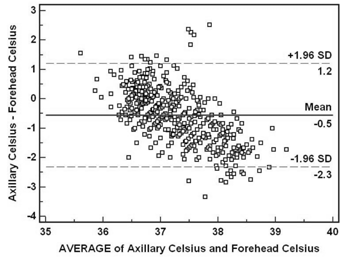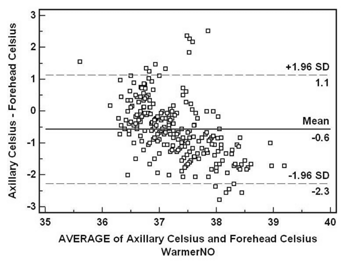|
|
|
Indian Pediatr 2013;50: 1153-1154 |
 |
Comparison of Forehead Infrared Thermometry
with Axillary Digital Thermometry in Neonates
|
|
*Ankur Sethi, *Dipen Patel,
$Archana
Nimbalkar, #Ajay Phatak
*#Somashekhar
Nimbalkar
From the *Departments of Pediatrics and Physiology,
Pramukhswami Medical College, Karamsad, Anand, Gujarat; and #Central
Research Services, HM Patel Academic Center, HM Patel center for Medical
care and Education, Karamsad, Anand, Gujarat: India.
Correspondence to: Dr Somashekhar Nimbalkar,
Department of Pediatrics, Pramukhswami Medical College, Karamsad,
Anand,Gujarat 388 325, India.
Email: [email protected]
Received: May 1, 2013;
Initial Review: June 10, 2013;
Accepted: July 04, 2013;
Published online: July 5, 2013.
PII: S097475591300448
|
Fluctuations in core body temperature beyond a narrow range are of
concern as they indicate changed homeostasis. Thermoregulation
remains a key aspect of neonatal care. New ‘non touch’ method of
measuring temperature may reduce infection rate and discomfort of
neonates. Body temperature of neonates admitted in Neonatal
Intensive Care Unit was measured using axillary digital thermometer
and a handheld infrared non touch thermometer. The two methods did
not agree well (mean difference = -0.5, 95% limits of agreement:
[-2.3, 1.2]). The agreement was similar with a negligible difference
when patients in open care warmers were excluded (mean difference =
-0.6, 95% limits of agreement: [-2.3, 1.1]). As the accuracy is
unsatisfactory, the said technology needs further improvement before
it can be adapted for routine patient care.
Keywords: Measurement, Methods, Neonate,
Temperature.
|
|
A
ccurate temperature recording
remains an essential component of neonatal care. The best method to
measure temperature should accurately reflect core body temperature and
should not be affected by external factors. Axillary temperature
measurement is recommended by American Academy of Pediatrics and
National Association of Neonatal Nurses [1]. Mercury glass thermometer
has been replaced by digital thermometer that is safer and more
convenient.
Furthermore "minimal contact" being the guiding
principle in neonatal care, more convenient methods have been developed
to replace axillary thermometry [1].
The forehead is an excellent area to measure
temperature as it is supplied by temporal artery, which receives high
blood flow from the carotid artery. The concept of measuring forehead
temperature with help of infrared thermometer seems promising as a
simple, fast and convenient method, both for doctor/nurse and the
patient [2].
We compared the temperature of neonates measured
using Infrared forehead thermometer (IRFT) and digital axillary
thermometer (DT). Unlike previous studies, many neonates in our study
were managed in open care warmers. The study was approved by
institutional Human Research Ethics Committee.
Methods
A prospective study was conducted to determine
agreement between two methods of temperature assessment of newborns at
Neonatal Intensive Care Unit (NICU) of the Shree Krishna Hospital,
Gujarat, India. Neonates admitted in the NICU were enrolled in the study
irrespective of their gestational age and diagnosis through convenience
sampling. Quick Shot Infra-red Thermoscope (HT-F03B) was used to measure
forehead temperature and Smart Care - Digital Thermometer (SCT01) was
used to measure axillary temperature. Infrared forehead thermometry was
held at 0.5 cm (approximately) from mid-forehead for recordings.
Axillary temperature was taken after wiping underarm with dry towel and
Digital thermometer probe tip was placed under the arm so the tip
remained in contact with skin and the temperature reading was recorded
after the beep sound from Digital thermometer. Structured training was
imparted to nursing staff about the procedure and technique of using
IRFT and DT.
Temperature readings were taken from newborns kept
under radiant warmers as well as newborns kept on cot with their
mothers. A skin probe was used with a set temperature of 36.5 ºC
for neonates in NICU who were kept under open care servo-controlled
radiant warmer. A room temperature of 25ºC-30ºC
was maintained for neonates kept in intermediary care unit on cot. A
single reading by each method was recorded 3 hourly in neonates for 7
days. A total of 520 readings were recorded in Celsius unit from 12
neonates. To study the degree of agreement between the two methods,
standard methods suggested by Bland and Altman [3] were used and the
mean difference with 95% confidence limits was reported for clinical
consideration. A difference of 0.5ºC
was considered clinically acceptable.
Results
The body temperature measurements by axillary and
forehead methods did not agree well (mean difference =
-0.5 0C, 95% limits of
agreement: [-2.3, 1.2]) (Fig. 1). The agreement was
similar with a negligible difference when patients in open care warmers
were excluded (mean difference = -0.6ºC,
95% limits of agreement: [-2.3, 1.1]) (Fig. 2).
 |
 |
|
Fig. 1 Bland–Altman plot showing
comparison of body temperature measurements by axillary and no
touch ( 0 C) of all neonates, and
(b) excluding neonates kept in warmer.
|
Discussion
Infrared forehead thermeter was reported to be a
simple, noninvasive instrument for measuring temperature accurately.
Chiappini, et al. [2] reported a good agreement (mean difference
= 0.07 0C, 95% limits of
agreement: [-0.62, 0.76]) between Infrared forehead thermometry (IRFT)
and axillary thermometry using glass mercury thermometer in pediatric
population. In contrast, Fortuna, et al. compared IRFT to rectal
thermometry in 200 children aged 1 month to 4 y with a mean age of 1.4 y
and reported a broader 95% prediction band (on the order of 4ºF)
which is clinically not useful. Moreover, the infrared measurements
overestimated rectal readings in hypothermia and underestimated rectal
measurements in fever [4]. In the current study, we found a broader band
for 95% limits of agreement and higher mean difference, Sener, et al.
[5] reported similar result with slightly narrower band for 95%
confidence limits (mean difference = 0.2ºC,
95% limits of agreement: [-1.2, 1.6]) in adult population [5]. Many
factors may contribute to this discrepancy of findings from different
studies. Previous studies have been conducted in different settings like
NICUs, wards as well as in populations of different ages.
|
What This Study Adds?
• Infrared forehead thermometer provides
unsatisfactory accuracy as compared to digital theomometer.
|
References
1. Martin SA, Kline AM. Can there be a standard for
temperature measurement in the pediatric intensive care unit? AACN Clin
Issues. 2004;15:254-66.
2. Chiappini E, Sollai S, Longhi R, Morandini L, Laghi
A, Osio CE, et al. Performance of non-contact infrared
thermometer for detecting febrile children in hospital and ambulatory
settings. J Clin Nurs. 2011;20:1311-8.
3. Bland JM, Altman DG. Statistical methods for
assessing agreement between two methods of clinical measurement. Lancet.
1986;1:307-10.
4. Fortuna EL, Carney MM, Macy M, Stanley
RM, Younger JG, Bradin SA. Accuracy of non-contact infrared thermometry
versus rectal thermometry in young children evaluated in the emergency
department for fever. J Emerg Nurs. 2010;36:101-4.
5. Sener S, Karcioglu O, Eken C, Yaylaci S, Ozsarac
M. Agreement between axillary, tympanic, and mid-forehead body
temperature measurements in adult emergency department patients. Eur J
Emerg Med. 2012;19:252-6.
|
|
|
 |
|

